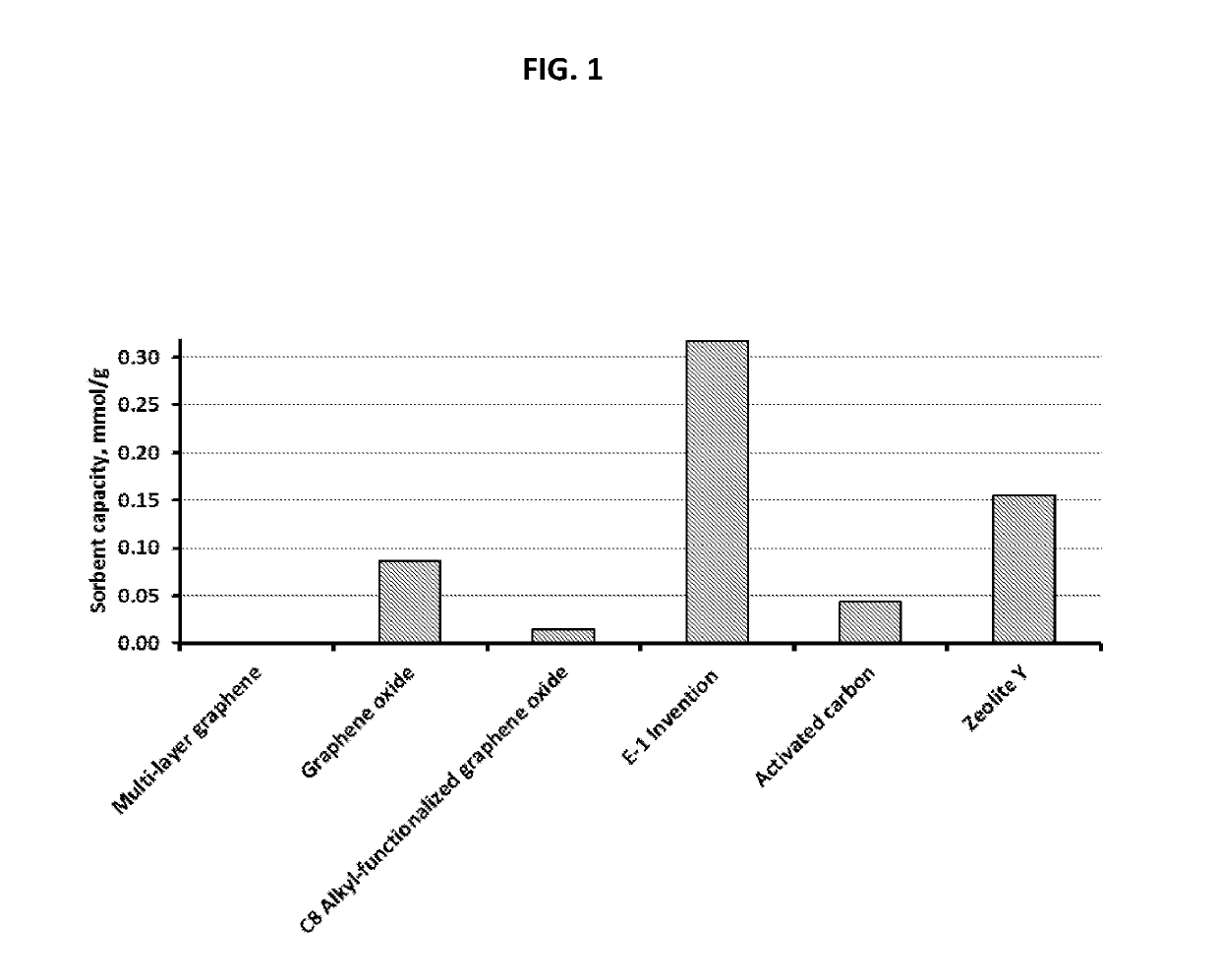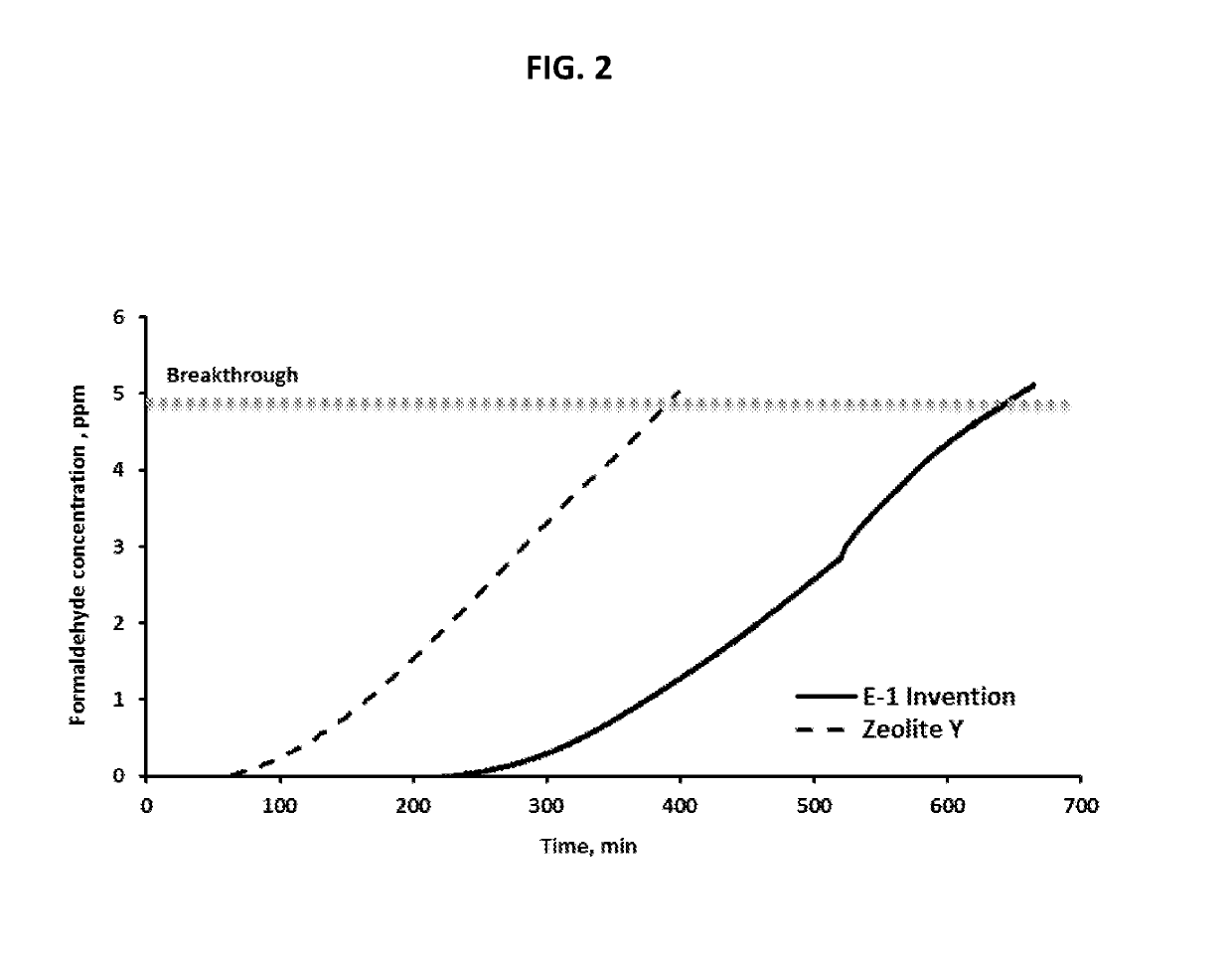High capacity regenerable graphene-based sorbent
a graphene-based sorbent, high-capacity technology, applied in the direction of dispersed particle separation, other chemical processes, separation processes, etc., can solve the problems of zeolites and activated carbons being prone to loss of sorbent capacity and mass, unable to meet air pollution regulations, and regeneration of activated carbons also posing fire hazards, etc., to improve the sorbent capacity of voc, less thermal degradation, and improved regenerability
- Summary
- Abstract
- Description
- Claims
- Application Information
AI Technical Summary
Benefits of technology
Problems solved by technology
Method used
Image
Examples
embodiments
Example 1 (E-1)
[0055]A rig for adsorption and desorption testing was constructed as follows. A single fixed sorbent bed comprising a cylindrical tube [stainless steel, 1.5 inch inner dia. (3.8 cm), 10 inch length (2.5 cm)] was fitted at each end with a flow line and conventional flow control valves, on the upstream end for controlling a flow of gaseous feedstream into the bed and on the downstream end for exiting an effluent flow from the bed. The tube was provided with a voltage controller and wrapped with a heating tape so as to provide heating to the bed. A humidity control was connected to the upstream flow line to provide gaseous water to the feedstream. The downstream effluent line was connected to a gas chromatograph and a formaldehyde detector (Interscan Corp., RM Series).
[0056]A sorbent (700 mg) of nitrogen and oxygen-functionalized graphene was employed, which ensured no by-pass or channeling of contaminated air through the sorbent bed. The sorbent was prepared by thermal ...
example 2 (
E-2)
[0064]The process of the invention was evaluated under conditions of multiple adsorption-desorption cycles for the purpose of evaluating regeneration capacity of the sorbent of the invention exemplified in E-1. The apparatus and test conditions were similar to Example E-1 with some exceptions. In order to achieve faster formaldehyde break-through to achieve multiple adsorption-desorption cycles within a reasonable time frame, the formaldehyde concentration in air was decreased from 10 ppm as used in E-1 to 7.5 ppm for this example. In addition, the space velocity of the contaminant feedstream was increased from 0.75 slpm as used in E-1 to 1.4 slpm in this example. The amount of sorbent was decreased from 700 mg as used in E-1 to 100 mg in this example. These modifications of the test method ensured contaminant break-through within approximately 1 h allowing for a more rapid testing procedure. Break-through was again defined as the point at which the outlet contaminant concentrat...
example 3 (
E-3)
[0067]The process of E-1 was repeated with the exception that the test conditions were as follows: 7.5 ppm formaldehyde in air; 1.4 slpm flow of contaminated air; and relative humidity increased from 10 percent to 40 percent. For the increased humidity, an aqueous solution of formaldehyde (37 wt. percent in water stabilized with 10-15 wt. percent methanol) was dispersed in an air stream with a syringe pump to yield the target inlet concentration of formaldehyde and water. The test employed the same pressure, temperature, and space velocity parameters as for the adsorption cycle used in E-1. The process was run through four adsorption-desorption cycles. Regeneration was effected at room temperature for cycles 2 and 3 and thermally at 150° C. for cycle 4.
[0068]Results are shown in FIG. 6 and FIG. 7. In cycle 1, as shown in FIG. 6, approximately the same capacity was measured at 40 percent relative humidity (0.0.25 mmol / g sorbent) as compared with the 10 percent relative humidity o...
PUM
| Property | Measurement | Unit |
|---|---|---|
| Temperature | aaaaa | aaaaa |
| Temperature | aaaaa | aaaaa |
| Temperature | aaaaa | aaaaa |
Abstract
Description
Claims
Application Information
 Login to view more
Login to view more - R&D Engineer
- R&D Manager
- IP Professional
- Industry Leading Data Capabilities
- Powerful AI technology
- Patent DNA Extraction
Browse by: Latest US Patents, China's latest patents, Technical Efficacy Thesaurus, Application Domain, Technology Topic.
© 2024 PatSnap. All rights reserved.Legal|Privacy policy|Modern Slavery Act Transparency Statement|Sitemap



